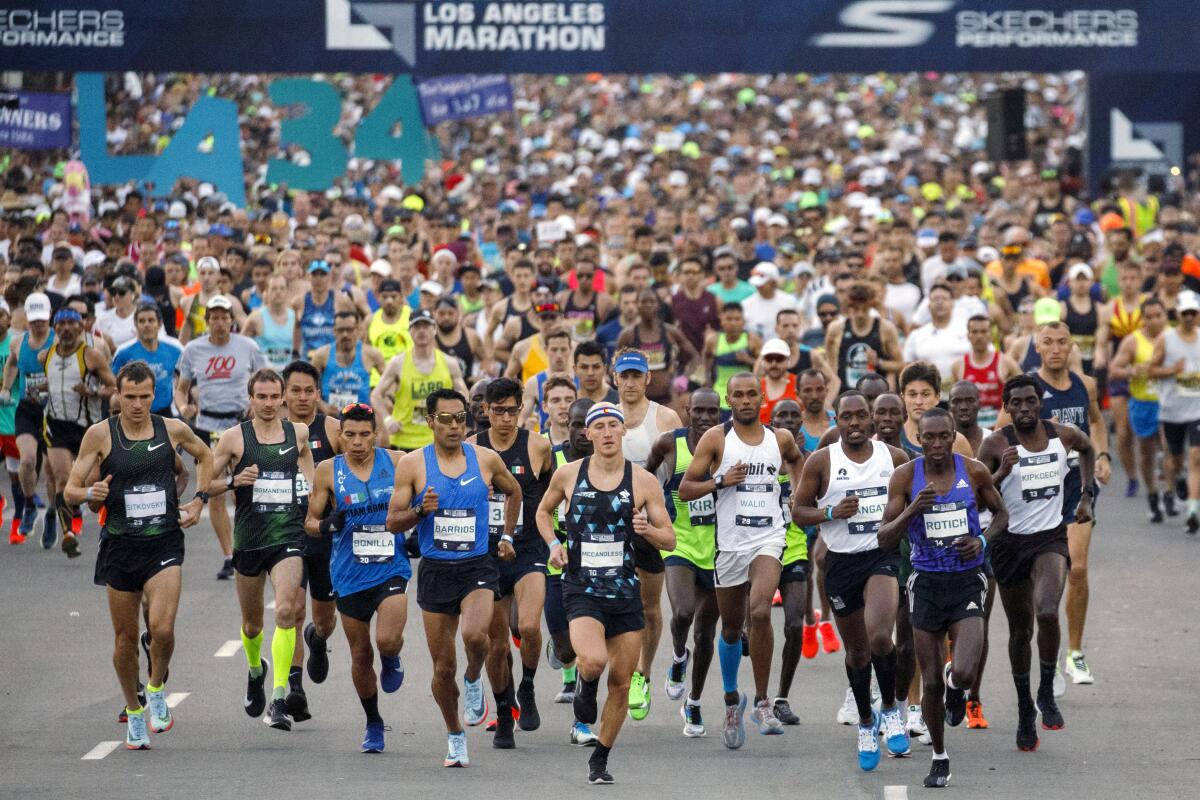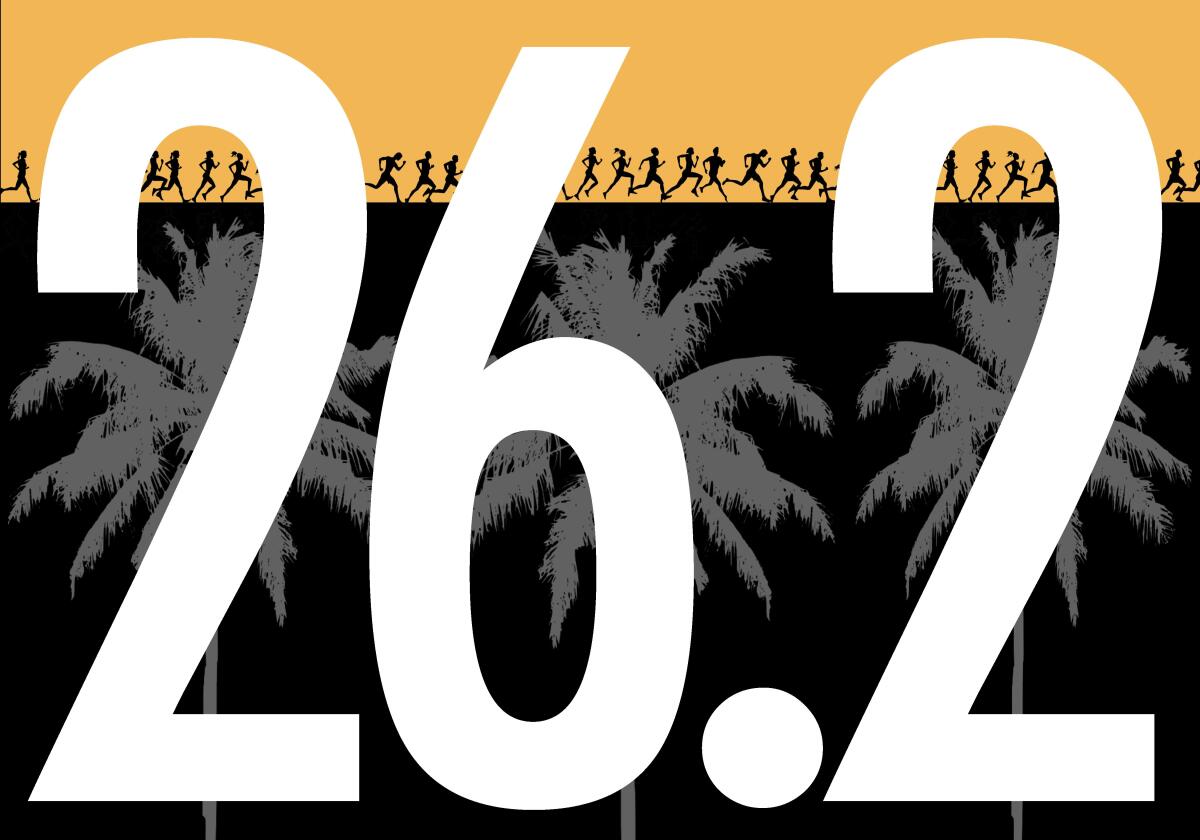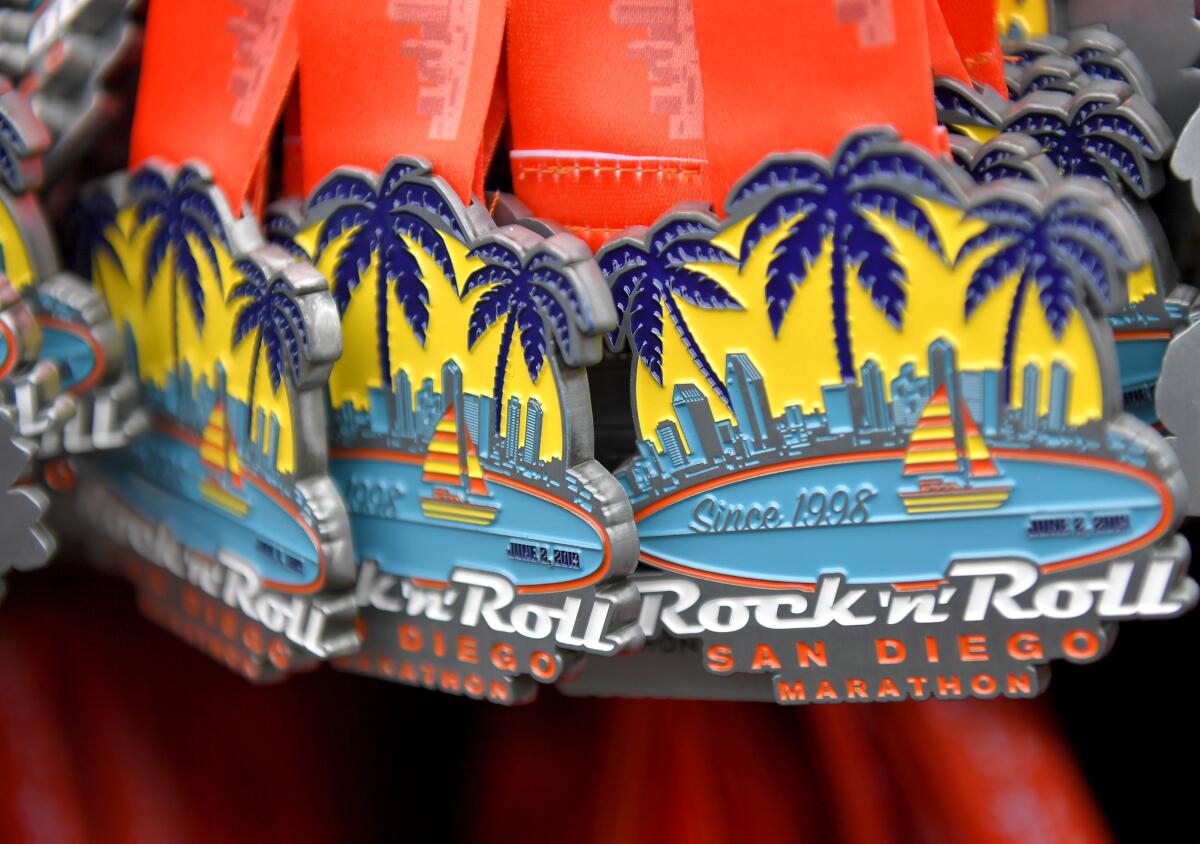Why your marathon training starts now

- Share via
You’ve decided to run a marathon. Congratulations. When should you start training? Soon. Popular group training programs for the L.A. Marathon on March 8 start as early as August.
What kind of shoes should you get? How far should you run? How fast should you run?
Whoa! Slow down. First things first. As someone who has run 38 marathons in the past 20 years, I offer this as my No.1 tip to newbies and returning runners: Grab hold of a running friend or a club or a group to run with. And when the going gets tough, don’t let go.
“I’m always telling newcomers that the power of the group is pretty amazing,” says David Prager, president of the L.A. Leggers, a running club that meets for group runs on Saturdays from August to March near the Santa Monica Pier.
“A lot of people can show up and run a handful of miles pretty easily, but when the runs get to a significant distance — 10 miles, 16 miles, 18 miles — the power of the group can really give you motivation to stick with your training program.”
A running club like the Leggers or the L.A. Road Runners charges an annual fee ranging from around $50 to $100. For that, you will typically get a training T-shirt, a training program and some individual or pace-group mentoring.
Clubs typically welcome anybody from newcomers to Boston Marathon qualifiers and provide pace-group runs to meet any person’s running level.
Maybe most important, you get a chance to form relationships. Running relationships. And that, to me, makes all the difference in sticking with a running program, whether you’re training for your first marathon or, like me, your 39th.
When I started training in my early 40s, I was into the numbers: how fast, how far. And that worked for a while. I had a good first marathon, qualified for and ran Boston, and kept trying to get faster and faster. Almost all my training runs for years were by myself. Many years and marathons later, I look back and realize I was missing the point of the long run.
These days, the loneliness of the long-distance runner is not so appealing to me. One of the main reasons I get up early on Saturdays and meet my friends for a long trail run in the Santa Monica Mountains is to nurture relationships I treasure dearly.
Those friendships have become the core of my running. I never joined an organized running club, but for a dozen or so years I have been in an unofficial club of runners — old and young, men and women — who meet weekly for a long run.
I am so grateful that numbers no longer tell the story of my long runs. I look forward to the long runs — and the long talks — with Craig and Marisa and Louise and the rest. Jake no longer runs with us, but our friendship has outlasted our running partnership.
“We see all the time that lasting friendships form out of our pace groups,” says the Leggers’ Prager.
That’s what I hope newcomers can find. There are so many benefits to running with friends.
▶ It keeps you accountable. You know your buddies are going to be there (and they’re going to talk about you if you don’t show).
▶It motivates you. You might share a common goal. You might even decide to run together at the L.A. Marathon. That’s a bond that will keep you going.
▶ It nurtures you. Therapists and counselors will tell you that almost nothing is more destructive than isolation. Did you ever wonder why diets often don’t work? Maybe it’s because people mostly do them alone.
“For the first-timer, taking on a marathon is really a lifestyle change,” says Murphy Reinschreiber, chief operating officer of the Conqur Endurance Group, which produces the L.A. Marathon. “Getting to the start line is a huge part of the job. Training with a group is the best way to get you there in good physical and mental shape.”
So how do you find a running group? There are no shortage of places to look.
Clubs
Two of the most established groups in L.A. are the L.A. Road Runners (lamarathon.com) and the L.A. Leggers (laleggers.org). The Road Runners are the official training program of the L.A. Marathon. Organizers are announcing changes to their program Saturday (details can be found at (lamarathon.com). Other groups worth considering are the Pasadena Pacers (pasadenapacers.org), South Bay Runners Club (southbayrunners.org) and BlacklistLA (blacklistla.city), this last one organizing weekly late-night runs visiting street art around the city.
Charities
Some runners like to use their favorite charitable organization as a motivation to train for a race. This method includes a responsibility for fundraising in return for training information, access to coaching and race-day support. The best-known is Team in Training (teamintraining.org), which since 1988 has raised more than $1 billion toward researching a cure for cancer.
Online training
If you are allergic to clubs, there are many options online for training programs that you can do on your own or, preferably, with friends. Three of the best are jeffgalloway.com, halhigdon.com and runnersworld.com.
There is no perfect program, no one right way. There are lots of paths up Marathon Mountain. But remember this marathon training truth: Nothing succeeds like doing it with someone else.

26.2 tips for first-time marathoners:
1. Run with someone, especially on long runs on the weekend.
2. Start slow. Take it easy. This is going to take a while.
3. Every night, think about what shoes and clothes you’re going to run in, and lay them out.
4. Replace your running shoes every 500 miles.
5. Make time after hard runs to fix yourself a smoothie or a protein shake.
6. Alternate shoes. It’s good for your feet, and if something bad happens to one pair, you don’t have an excuse to skip your next workout.
7. Do not increase your mileage more than 10% from one week to the next. “Too much, too soon” is the biggest cause of injury.
8. Take at least one or two days a week off.
9. Keep a running log. One day you might want to look back and see what worked and what didn’t.
10. Run through discomfort, but do not run through injuries.
11. Adopt a mantra and use it. If you don’t have one, you can borrow mine: “If it were easy, anyone could do it.”
12. Don’t panic if you have to miss a planned workout. A missed day or two is not going to deter you from a long-term goal.
13. Vary your routes and your paces. Running the same course, the same distance, the same speed all the time will put you into a rut.
14. If you want to run fast, you have to run fast. That is, build faster runs into your weekly mileage.
15. Run in the morning. I know this isn’t easy for everyone. Once the day starts, it just gets more complicated.
16. Some people say “early to bed” is the best advice you can give someone who is training. I’m still working on it 21 years after my first marathon.
17. Keep a supply of healthy snacks around. I’ve been told this is a good idea, too. Personally, I like to mix in a box of Mike & Ikes.
18. Invest in a good set of bluetooth earphones. Wires are a pain.
19. Every fourth week, take an easy week. Run 25% less mileage than usual.
20. Please put on sunscreen. We have to remind each other of this. A hat and lip screen are also good ideas.
21. If you’re running on the road or street, always run on the left side, facing oncoming traffic. Never run on the right side, with traffic.
22. Always wear a RoadID or similar identification that includes a contact number.
23. If you go out for a workout and you’re just not feeling it, better to bail than to torture yourself. You can always give it another try the next day.
24. There is no substitute for the long run. If you don’t work your way up to at least a 20-miler in training, you’re asking for a miserable marathon experience.
25. Race. You don’t have to wait until your marathon. Enter a 5K, or a half-marathon, along the way. Racing is fun, and there’s no teacher like experience.
26. This one comes from my wife. Google the sentence “How do I get the stinky smell out of my running clothes?”
26.2. When you see another runner out there, wave or nod. We’re family, and we inspire each other.

Southern Californians have lots of local marathons to choose from. Check course maps and elevation profiles — want a tough hilly route or a flat beach run? — on the race’s website before you commit.
Long Beach Marathon, Oct. 13. It starts on Ocean Boulevard in downtown Long Beach and winds past the Queen Mary and Shoreline Village before heading out on a flat beach path to Belmont Shore and Marine Stadium, and then back to the start. motivrunning.com/run-longbeach
L.A. Marathon, March 8. Famously called “from the Stadium to the sea,” it is a one-way course that begins at Dodger Stadium and then through downtown, Hollywood, West Hollywood and Beverly Hills before reaching the ocean at Santa Monica. Some hills, sometimes super-hot, always lots of street-party fun. You’ll never run alone: This race attracts about 25,000 participants. lamarathon.com
Catalina Island Marathon, March 14. If you love rugged terrain, climbing more than 4,300 feet and amazing views, this challenge is for you. About 200 runners hit trails from the island’s west end at Two Harbors and run past Little Harbor and nearby beaches before finishing in Avalon. runcatalina.com
Rock ‘n’ Roll San Diego Marathon, May 30. The race promises music every mile as you run from the Gaslamp Quarter to Mission Bay and neighborhoods such as University Heights and Normal Heights. bit.ly/rocknrollsandiego
David Leon Moore, who covered sports around the country and the world for USAToday for 33 years, lives in Moorpark. He plans to run his sixth L.A. Marathon in March and his 12th consecutive Boston Marathon in April.
More to Read
Sign up for The Wild
We’ll help you find the best places to hike, bike and run, as well as the perfect silent spots for meditation and yoga.
You may occasionally receive promotional content from the Los Angeles Times.










